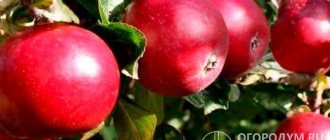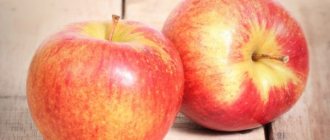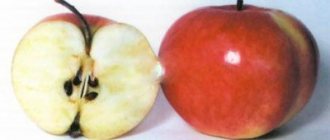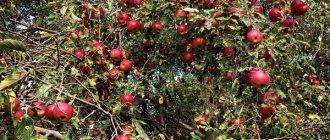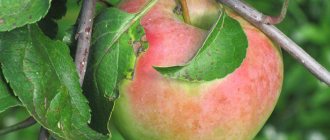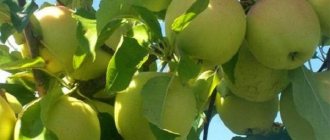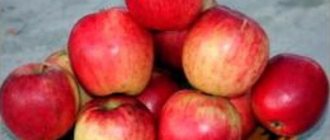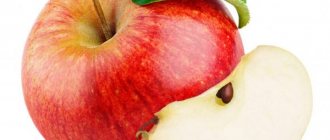History of selection
The Early Geneva apple tree was bred in 1964 in Geneva by breeders representing the New York State Testing Station. Scientists tried to cross-pollinate Cuban varieties, which have bright and large fruits, with pollen from apple trees growing in Switzerland and bearing fruit in July, using material from the Julired and Quinti varieties.
Did you know? Apple trees are considered quite long-lived trees: cultivated varieties live up to 100 years, and in the wild there are plants with a considerable age - from 150 to 300 years.
These varieties ripen early and have adaptations to cool climate regions. As a result, scientists received about 200 seedlings, which underwent variety testing in 1973. Among them, one variety with the number NY 444 was called Geneva Early. Gardeners began to grow the variety described in public since 1982.
Reviews
According to gardeners, the variety is really early and early ripening - the first apples appear at the end of July, and the main harvest ripens by mid-August.
The description of “Early Geneva” does not always agree on the taste of apples: for some they are tasty and sweet, for others they are sour.
Some gardeners believe that it is a matter of different amounts of light on the site - the more sun, the sweeter the apples.
According to reviews, the keeping quality of the fruit leaves much to be desired, but they do not stay stale - they are eaten immediately. In addition, they are convenient to process due to three-stage fruiting. The apple tree grows wide and spread out, which requires appropriate care, but it rewards with excellent harvests every year.
Description and characteristics of the variety
Geneva apple trees have the following characteristics:
- the crown is dense, wide-pyramidal, flat-round or spreading, with drooping branches;
- due to good growth at the beginning of life and moderate growth during fruiting, an adult tree can reach a height of 3.5 to 5 m;
- foliage of rich dark green shades, densely pubescent on the reverse side, oblong, the base is pointed or rounded, the tip is pronounced;
- blooms early, with saucer-shaped white inflorescences;
- the variety is self-sterile, therefore it needs the proximity of pollinators;
- mixed fruiting culture, using different fruit bases (spears, ringlets);
- the apple tree has early fruiting qualities - the first harvest of fruit products is possible a year after planting the seedlings;
- are distinguished by regular fruiting;
- fruits are medium or larger, conical-round or rounded-flat; the color of apples is greenish; on the sides - a reddish blush;
- the ripening time is uneven (from the first ten days of July to the end of the month), so the fruits can be collected in several stages;
- tasting indicators of taste characteristics: crispy white-greenish, juicy pulp with small grains - 4.7 points; The taste of apples is sweet and sour, there is a pronounced aroma; spicy wine-sweet notes are felt;
- Products are stored in the refrigerator for up to 3 weeks.
Did you know? In Ancient Rus', burns were treated with baked apples. To do this, apple pulp was applied to the burn, which allowed the victim to quickly relieve pain.
Advantages and disadvantages
- The positive features of the apple trees in question are:
- precociousness;
- beautiful external characteristics of apples;
- fruits ripen early and at different times;
- regularity of harvests;
- high tasting assessment of the taste of apples.
- The disadvantages of these apple trees are:
- with improper care, resistance to powdery mildew and scab may decrease;
- low transportable qualities;
- short shelf life of products.
Productivity
Apple trees are characterized by a high degree of fruiting: up to 125 kg of fruit are harvested from each crop during the growing season, each weighing 150–200 g.
Pollinators
Suitable crops for pollination are:
- Golden Delicious;
- James Grieve;
- Delicacy;
- Discovery;
- Celeste;
- Elstar;
- Idared;
- Ambassi;
- Gloucester.
Ripening and fruiting
The apple tree blooms in early spring. Fruiting is mixed. This means that the fruits develop on different parts of the tree, but most often on the ringlets. The variety is early fruiting.
Important! A tree grafted onto a dwarf rootstock bears fruit in the second year after planting.
The tree bears fruit regularly every year . The average yield is up to 50 kg per tree. The fruits are medium sized and round in shape. Apples ripen unevenly throughout July. Harvesting begins in mid-August.
Early Geneva harvest begins in mid-August.
Subspecies
Since trees of this variety reach a height of 5 meters and have a wide crown, growing their dwarf and columnar varieties is not practiced.
Fruit storage
Apples have a pronounced sweet and sour taste and juicy pulp. They do not store for long, up to about three weeks in the refrigerator . They are immediately consumed as food or processed into juice.
The main thing that gardeners value this variety of apple trees for is the yield and taste of the fruit . By properly caring for and caring for the tree, you get a high-quality harvest.
Try planting this variety - the Geneva Early apple tree (you saw the description and photo of it above) will certainly please you with its characteristics.
Planting seedlings
In order for the harvest of the apple variety of the crop described to be of high quality, the seedlings must be planted in the “right” place. For these purposes, use areas with good lighting. At the same time, it is important to take into account the tallness of plants of this variety and their wide crowns, so they are not suitable for a small garden.
Deadlines
Apple trees are planted in autumn or spring:
- Autumn planting will help trees adapt to a new environment over the winter, and their root system will strengthen. In autumn, planting is carried out in mid-October, with the expectation that with the onset of spring, during the period of persistent warmth, young trees will begin to actively grow and develop.
- In the spring, apple trees are planted after the ground has thawed and warmed up well (late April - early May). At such a time for planting trees, they must be watered frequently and abundantly, which will not allow the roots to dry out. Trees will be able to strengthen well before the winter cold and, subsequently, survive the cold season without loss.
And when choosing seedlings, we advise you to pay attention to its appearance.
Technology
Planting apple trees is carried out using the following technology:
- In an area that has been previously dug up and cleared of weeds, dig planting holes (60 cm wide and 70 cm deep).
- Place pebble drainage at the bottom of the holes.
- Mix the soil removed from the holes with humus, ash, and mineral fertilizer.
- Insert a stake into each hole to tie the seedlings.
- Place the trees in the center of the holes, leveling their roots and filling them with prepared soil mixture.
- The soil around the seedlings is compacted, leaving a part of the grafted stem on the surface of the soil.
- Tie each seedling to a stake using a rope.
- Water the trees generously three times: after each watering, you need to wait until the moisture is absorbed into the soil, and then continue working.
- Mulch the hole around the seedling. To do this, use humus, grass residues, and rotted sawdust. This will avoid overgrowing with weeds and help maintain humidity at the proper level in the tree trunk.
- Build a berm around each tree to facilitate watering and keep the water from spreading.
Features of planting and care
Landing
Deadlines
- The condition of the soil determines the exact timing of planting the apple tree;
- It doesn't happen year after year. Even in the same place;
- In spring it should be warmed up. This time comes in April;
- And in the fall you need to wait for the leaves to fall: And give the seedlings the opportunity to prepare for winter;
- Give them 20-25 days before frost sets in;
- And this is the end of September. Or early October.
Important!
- Do not plant seedlings in rainy weather;
- Bury the seedlings until favorable conditions occur.
Scheme, technology
Planting patterns depend on your goals and conditions. And rootstocks of seedlings:
The semi-dwarf clonal rootstock 54-118 ensures frost resistance and vital activity of the garden for over 30 years. And even 35 years; And the distance between trees in a row can be 3.0-3.5 m
And between the rows - up to 4.0 meters. Select good quality seedlings: Give preference to two-year-olds; Seedlings with a closed root system;
Pay attention to the root system. Without damage and not dried out.
Wrap in damp cloth; Cover with damp sawdust or damp soil; Dig it in
If there is still a lot of time before disembarkation; You can prepare a clay mash. Wet the roots before planting.
Select a landing location:
- Well lit and accessible to sunlight;
- This variety is grown even on heavy soils. And on soils with high groundwater. At least that's what they write.
Prepare planting holes:
- Consider the size of the roots - but not less than 60-80 cm deep and up to a meter in diameter;
- Prepare them in advance: For planting in spring - autumn;
- For planting in autumn - 15-20 days;
Proper planting of an apple tree.
Necessarily:
- Install pegs and tie up seedlings. Water generously when planting (2-3 buckets);
- The root collar should be 4-6 cm above ground level.
Agricultural technology and cultivation
Well-known agricultural techniques make it possible to realize the full potential of the apple tree and have a good annual yield of high-quality and beautiful apples:
Watch the soil. Dig and mulch;
Water your trees regularly. Taking into account weather conditions in your area. But at least 2-3 waterings: Before the apple tree blooms; During the formation of the ovary; Drip irrigation will significantly improve the watering situation;
Combine them with fertilizing: foliar and under the root; Carry out preventive treatments against diseases
Pay attention to early spring treatments and preparation for winter; Carry out 3-4 treatments with insecticides against pests. There are more of them than we would like
Sucking, gnawing. And not only.
Advice!
- Do not be tempted to buy inexpensive drugs and save your money;
- Purchase insecticides and fungicides in specialized stores;
- So do fertilizing;
- Avoid overloading the crop. Thin out the ovaries.
Pruning and crown formation
Proper pruning of apple trees.
Not tall trees allow you to create convenient crown shapes.
The sparse crown will allow you to choose the one that is convenient and most suitable for the variety.
You can choose from a variety of natural ones:
- Sparsely tiered;
- Cup-shaped;
- Bushy;
- Fusiform.
And there is always a desire and interest in original artificial ones:
- Trellis;
- Palmetta;
- Cordon;
- Sphere.
Carry out the necessary pruning in the spring before sap flow begins:
- Formative. To create a mold for young apple trees;
- Sanitary. Remove diseased, dry, damaged branches;
- Structural. Cut out branches that cross and grow inward;
- Rejuvenating. This is already at a respectable age.
Very important!
- Use sharp and clean tools;
- Make cuts carefully;
- Cover the cuts with garden varnish.
Pollinator varieties
Its creators, experts, consider it even partially self-fertile.
The apple tree is self-pollinating.
But among the best pollinators are:
- Golden and Red Delicious;
- Idared;
- Gala;
- Elstar;
- Rubinette.
You won’t plant just one Elsa apple tree in the garden! And conduct an experiment on the partial self-fertility of the variety.
Seedling care
They care for the crop of the described variety in the same way as for other apple trees.
Watering
They use different methods of moistening the crop:
- Surface hydration. It is carried out using a hose into a ditch dug around the crown, one-third of the depth of the shovel blade. Water is added until intensive absorption stops.
- Sprinkling. Fine, uniform and dispersed spraying of water is carried out using sprinklers of various configurations (fan, impulse, pistol). The soil is moistened to a depth of 80 cm.
- Drip method. In this case, moisture is constantly supplied, in micro doses, to the roots of the trees.
1 - Surface irrigation;
2 - Sprinkling; 3 - Drip irrigation. The rate of moisture depends on the age of the plantings. During the first 5 years, trees need light but frequent moisture.
One-time watering implies the following volume of water (per square meter of space adjacent to the tree):
- 1-year-old trees - up to 30 l;
- 2-year-olds - up to 50 l;
- 3–5 year old plants – 50–80 l;
- at the beginning of fruiting and an adult apple tree (6–10 years old) - up to 70 liters.
Important! Water should not stagnate in the area of the root collars of apple trees, as this contributes to their rotting, disease and death of the trees. Therefore, it is necessary to organize the flow of water from each tree to the outer edges of the crown perimeter.
Apple trees are watered at the following times:
- water for the first time in the spring before the leaves bloom;
- in warm and dry weather, plants up to 5 years of age must be watered once every 7 days;
- For adult trees, subsequent irrigation is carried out after budding during the formation of apples;
- in the heat - additionally water during the period of pouring apples (if there is a lack of moisture, the apples will become smaller and fall off);
- The last watering of apple trees is carried out during the phase of active fruit mass gain or 2 weeks before harvesting;
- watering during the harvest period or immediately after it is inappropriate: excess moisture will lead to the growth of young shoots and their freezing in winter;
- in October (if the autumn has been long, dry and hot), moistening is carried out for preventive purposes to protect the wood from drying out and freezing in winter.
Top dressing
Regular feeding has a positive effect on the quality of the fruit.
Apple trees need to be fed according to the following schedule:
- in spring - from mid-March to mid-April;
- in summer - the first half of June;
- first feeding in autumn: August - September;
- second autumn fertilization of fruit crops: September - October.
Apple trees are fertilized with organic and mineral fertilizers.
Organic ones are used:
- Fresh manure. It is applied in a slurry state, for digging, during the growing season (per 1 m² - 10 kg of manure). To prepare a liquid composition, you need to take 1 kg of manure and dilute it in 10 liters of water, let it sit for 1 week.
- Humus. Application rates are the same as for fresh manure.
- Chicken droppings. During the initial spring digging and the final autumn plowing, dry droppings are used. Liquid fertilizer is used during the season in the form of a mixture of 100 g of litter diluted in 15 liters of water (let stand for 10 days).
Check out
How to make an apple tree bloom and bear fruit?
Mineral supplements are:
- Nitrogen fertilizers (“Urea”, urea). They are applied: in the spring for trees to grow healthy and lush crowns; in summer - to stimulate fruit formation.
- Phosphorus preparations (“Superphosphate”, etc.). Phosphate flour (200 g/1 m²) is also added to the apple trees.
- Potash fertilizers (“Potassium sulfate”, etc.). The crops are fed with potassium preparations in the fall, and by spring the fertilizers will have time to be completely absorbed in the soil and will become available.
All minerals are used in compliance with the standards specified in the instructions for the drugs.
Pruning and crown formation
Apple trees are pruned for the first time the next season after planting, and then annually.
Pruning is carried out according to the following rules:
- The crown is formed at the beginning of the growing season. If it is too thick, it is thinned out, completely removing dried and frozen shoots.
- For a seedling without side shoots, the main trunk is cut 20 cm above the planned branching site to form a crown.
- In a branched plant, the central trunk is also shortened and low-lying branches are removed.
- During pruning, you should be careful not to cut off shoots with formed fruits, since an improperly pruned tree may reduce the yield.
Preparing for winter
When preparing for wintering, apple trees need to be protected from the cold.
Important! Apple trees should not be covered with straw from grain crops, otherwise this may attract rodents to the trees.
Principles of insulating apple trees for the winter:
- It is necessary to decide on the correct period for covering the crop: protection must be built after the sap flow in the trees has stopped and the air temperature has reached sub-zero (-10°C).
- You need to choose the right covering materials to protect the trunk from rodents: spruce branches, fine mesh, burlap and cardboard are best suited.
- You can fix materials on tree trunks with tape or fabric tapes, but not with wire, which can damage the tree bark.
Loosening and mulching
In the last autumn days, the soil adjacent to the trunks should be loosened or dug up, and also covered with mulch. This will help in the fight against garden pests, and will also serve as additional insulation.
The following technology is used:
- The blade of the shovel is placed along the perimeter line of the tree trunk circle (to prevent damage to large plant roots). For light soils, you can use special forks.
- It is necessary to correctly calculate the depth of treatment: closer to the trunk, the depth should be smaller (near the trunk it should be no more than 8 cm, the remaining area is treated to a depth of 12 cm).
- When preparing apple trees for winter cold, mulching is necessary to protect the top layer of soil from freezing and drying out: mulch is laid out around the trees along the diameter of their crowns. Hay, peat or sawdust are suitable for mulch (the layer should not exceed 15 cm).
Did you know? Old apple trees without shelter for the wintering period can withstand frosts above –30°C.
Features of agricultural technology
Since the crown of this tree is spreading, it is not recommended to plant the apple tree close to other trees. As stated above, the soil must be fertile, and if it is acidified, then before planting the seedling, you need to treat the hole with dolomite flour (200 g per 1 sq. m) and ash. Reproduction is carried out, as with other varieties, by grafting onto a rootstock, but most often summer residents buy ready-made seedlings from a nursery.
Agricultural technology for this variety comes down to timely fertilizing, to which this variety responds very well, and proper pruning. In the spring you need to add humus, maybe a little mineral fertilizer and urea. This is done twice - first at the moment of bud break, and then at flowering. The third, very important feeding should be done at the moment of fruit filling. Summer feeding should provide the tree with nitrogen and potassium. In this sense, a mixture of chicken manure with an infusion of green grass would be an excellent feed. And when the apple tree bears fruit, it can be supported in the fall with ready-made potassium fertilizer.
Important! Pruning is done the next year after planting. This helps keep the crown well-groomed and makes it easier to thin out excess branches, since this variety is prone to thickening. Pruning can be done only at the beginning of the growing season, also removing branches that have frozen over the winter.
Scheme for correct pruning of an apple tree Geneva
Diseases and pests
With insufficient or improper care, Geneva apple trees can be susceptible to disease and attack by parasites.
Here are some of the diseases:
- Scab. The fruits become covered with dark brown spots and cracks, and the leaves dry out prematurely. A control measure is to treat trees by spraying with a urea solution (0.5 kg per 1 liter of water) or with the preparations “Gamair” and “Rayok”.
- Cytosporosis. Characterized by the appearance of ulcers on the bark of trees. In the advanced stage, the wounds have a red-brown color, and if treatment is delayed, the tree may die. The problem is solved by pruning all affected parts of the branches, as well as whitewashing and irrigation with Hom.
- Powdery mildew. The disease is characterized by damage to the buds, foliage and bark with a white coating. To solve the problem, use 1% Bordeaux mixture, as well as the products “Skor”, “Topaz”, “Hom”.
Read more about how to deal with scab on apple and pear trees.
Apple trees are affected by the following pests:
- borer beetles living in the upper layers of the soil;
- larvae of bark beetles-weevils that settle inside the shoots;
- silkworms: they hide in the bark;
- bark beetles - live under the bark;
- winter moths: they lay larvae near the buds;
- mites and psyllids living in the bark;
- apple moth;
- leaf rollers;
- apple flower beetles;
- codling moths.
Comprehensive autumn treatment of trees helps against apple pests, which includes:
- pruning branches and shoots;
- cleaning the trunk;
- fungicidal treatment,
- whitewash;
- cleaning leaves and falling leaves;
- digging up the earth;
- mulching the tree trunk circle;
- trunk strapping.
Important! All chemical preparations for treating trees against parasites must be used while protecting yourself with protective equipment: goggles, a respirator and gloves.
Main characteristics
- Apples smell very nice. The taste is classic.
- Fruit ripening is gradual, so from mid-July to the second half of August several harvests can be harvested.
- Already in the second year, a sufficient number of apples appear on the apple tree.
- Resistance to some types of diseases is at a fairly high level. This especially applies to diseases such as powdery mildew.
- Apples have excellent taste and are rich in minerals and vitamins.
- Fruits can be transported over long distances.
- This apple tree does not like to rest, and bears fruit every year.
- The harvest cannot be stored for a long time, so it is recommended to consume it fresh. Various preparations are also made from apples.
- Geneva Early requires the presence of a number of pollinator varieties.
- This apple tree has a stable immunity to some types of fungal diseases, which, unfortunately, cannot be said about scab. To avoid infection, the tree must be treated with fungicides.
Apple variety Airlie Geneva
Despite the fact that apples are available to consumers almost all year round, summer varieties of this crop are always welcome residents in the garden. They are the ones who open the new apple season, allowing all apple lovers, as they say, off the branch, to taste this juicy and healthy fruit without waiting for autumn. Currently, domestic gardeners have at their disposal many early varieties of both domestic and foreign selection. And it must be said that foreign cultures adapt very well to most of the territory of Russia. But today we’ll talk about a variety that loves warm and temperate climates - this is the Early Geneva apple tree. The culture belongs to the American selection, bred at the Geneva experimental station as a result of crossing the Quinti varieties (Canadian selection, Crimson Beauty x Red Melba) and Julired in 1964. Out of 176 seedlings, one was selected in 1973, which was initially identified as NY 444, and then renamed Geneva Early, or Early Geneva. Since 1982, the variety has been widespread in America. The American novelty was included in the State Register of Breeding Achievements of Russia in 2017 and received admission to the Central Black Earth region (Kursk, Voronezh, Belgorod, Oryol, Lipetsk and Tambov regions). The applicant and originator was Belogorye Gardens LLC. The variety is also familiar to gardeners in Ukraine and has taken root well in Crimea.
Description
The apple tree is characterized by average growth rates, but at a young age the growth vigor is much higher than that of a plant that has entered the fruiting period. As a rule, the tree is medium-sized, 2.5 - 3.5 meters high. But the size is greatly influenced by the rootstock, which is why plants are sometimes described as vigorous. The crown is medium dense, spreading, broadly oval. True, the State Register describes the shape of the crown as spindle-shaped. The branches are arranged compactly, extending from the trunk at an angle close to a straight line, the ends of the branches are always directed upward. The shoots are medium thick, covered with brownish bark, pubescent. The leaves are green, large, elongated-oval in shape, the apex is short-pointed, the base is arcuate, the edges are coarsely wavy and serrate. The surface of the leaf blade is matte, wrinkled, the nervation is rough. The petiole is uncolored, slightly pubescent, of medium length and thickness. Stipules are elongated, lanceolate. The flowers are five-petaled, saucer-shaped, white, medium in size. The edges of the petals are slightly wavy. Fruiting of the apple tree is of mixed type; the harvest is formed mainly on simple and complex ringlets. In the southern regions, the variety can bear fruit on last year's growth.
The fruits of Early Geneva are visually attractive, although they can hardly be called large. According to the State Register, the mass of an apple is about 90 grams, the diameter is approximately 8 cm. However, there is evidence from gardeners that the mass of the fruit can be quite heavy - 150 and even 200 grams. Apples are regular round-conical or flat-round in shape, with a smooth surface. The funnel is blunt-conical, medium in width and depth, without traces of rust. The saucer is wide, not deep, smooth. The calyx is medium, often closed. The peduncle is straight, oblique, of medium length and thickness. The skin is shiny, with a slight waxy coating. The main color is greenish, sometimes with yellowish tint. The integumentary covering occupies almost the entire surface of the fruit in the form of a blurred blush of red-pink color. Subcutaneous dots, due to their gray color and small size, are poorly visible against a bright background. The pulp is a pleasant, very light cream color, medium-dense consistency, fine-grained, tender, semi-oily, the aroma is pleasant, but weak. The taste is very good, sweet and sour, with spicy notes. The State Register defines the variety as a table variety. Tasting score from 4.1 to 4.5 points. But some gardeners call the taste rather sour. 100 grams of pulp contains: sugars 7.6 - 10.39%, dry matter 12.8%, iron 0.16 mg, magnesium 5 mg, phosphorus 11 mg, potassium 107 mg, vitamin C 4.6 - 10.5 mg.
Characteristics
- The apple tree is very early in fruiting. The tree begins to bear fruit within a year after planting. True, in order for the seedling to grow properly, it is recommended to remove the first flowering almost completely;
- flowering occurs early, but the flowers are resistant to cold snaps;
- Early Geneva attracts with its early ripeness. Or rather, even super early, since the fruits of our heroine ripen a whole week earlier than White Filling. The State Register classifies the variety as an early summer variety. In the warm Krasnodar region, the harvest can be harvested as early as mid-July. But the usual ripening period in central Russia and the USA is the last ten days of July - the first days of August. The early product is competitive in the market, so the variety is considered promising by small and large farmers;
- The process of fruit ripening does not occur simultaneously, which is why the harvest will have to be harvested in 2-3 passes. This characteristic makes industrial cultivation somewhat troublesome, but for a private garden, uneven ripening will extend the period of consumption. Moreover, the strength of attachment of the fruit to the branch is strong;
- The yield is annual and stable. Productivity is very good. The first fruiting will bring 5 kg, but every year this figure increases. According to the State Register, the average apple yield was 152.3 c/ha. Up to 50 kg of marketable fruits are harvested from one mature tree;
- winter hardiness for warm and temperate regions is quite sufficient. The tree can withstand frosts down to -26°C. The State Register assesses the plant’s ability to withstand unfavorable winter conditions as high;
- The variety has high drought resistance. But without watering, the fruits will be small;
- heat resistance is average. In very hot weather, metabolism in plant tissues decreases and development stops;
- Early Geneva's immunity is not high enough. Resistance to scab is weak. The State Register notes that up to 20% of the tree was affected by this disease. Other sources claim the apple tree is highly resistant to fire blight and powdery mildew. There is resistance to apple aphids;
- Birds attracted by the bright color of the fruit can cause significant damage to the crop;
- transportability is low. The pulp of apples is not dense enough; during long-term transportation, the fruits may receive mechanical damage and lose their presentation;
- the harvested crop can be stored in the refrigerator for about 3 weeks;
- They use the harvested crops universally. First of all, the variety is valued for its ability to use early apples in their natural form. But they are also suitable for recycling. From the fruits you can make fruit puree, baking filling, jam, mousse, juice, compote, cider, fruit salad.
Pollinators
Early Geneva is not a self-fertile variety. To enjoy decent results, you need to pair it with a suitable pollinator. But our heroine blooms very early, so choosing a neighbor is not so easy. However, there are apple varieties that will cope with the task perfectly. Among them are apple trees already well known to Russian gardeners and those not very familiar: Embassy (Embassy), Idared, Discovery, Delicatessen, Katerina, James Grieve, Yellow Olive.
Planting and care
Autumn or spring is suitable for planting the plant. But the procedure will need to be completed within the prescribed time frame. If you delay planting in the fall, the root system will not have time to adapt to the cold; spring delay will also adversely affect the overall development of the seedling. The rootstock is of great importance for the normal formation and future productivity of our heroine. In Russia and Ukraine, the M9 is most popular for these purposes. Suitable soils must have neutral acidity, be loose and nutritious. The best option is loam. It is best to prepare a planting site in a sunny area, although the apple tree can develop in partial shade. Formative and thinning pruning is best done in the spring, sanitary pruning - as needed. Weak resistance to scab will require utmost effort from the gardener, because not only preventive treatments will be needed. If the disease manifests itself, you will have to act immediately so that the fungus does not spread to the entire plant. Watering of mature trees is carried out as needed, maintaining soil moisture at a moderate level. For seedlings, the moistening procedure is carried out more often. Fertilizers are applied according to the standard scheme. But at the same time, carefully observe the leaves - their color and condition will tell you which element’s deficiency needs to be replenished as quickly as possible.
Apple tree Airlie Geneva
The Geneva apple variety is quite popular among summer residents and gardeners. These summer apples ripen earlier than Papirovka, which is known for its early ripening. They have excellent taste, which is combined with an excellent appearance. The apple is juicy, with a red blush.
This variety of apples is the result of selection by American gardeners, who in the 60s crossed the famous varieties Quinti and Julired. As a result, a new species has appeared, characterized by increased winter hardiness, as well as the ability to resist diseases common among apple trees.
Apple tree Geneva: description of the variety and characteristics
Before describing the characteristics of the variety, it is worth noting its features, which require a careful approach to agricultural technology:
- despite the fact that the species is classified as winter-hardy, the tree is afraid of spring frosts. Therefore, planting is usually done in late spring;
- The variety is early ripening, and therefore at the time of filling it is extremely responsive to watering and good nutritious soil. The Geneva apple tree feels great on black soil, but is not capricious to loam and sandy loam soil;
- needs aeration;
- uneven maturation allows harvesting to be done in 2-3 steps.
The variety is distinguished by the beautiful appearance of the fruits
For your information! This variety has no subspecies, including apple trees that are not made columnar or dwarf.
The flowering of this variety is remarkable. The tree is covered with a large number of pinkish-white flowers, which literally exude a strong and delicate scent.
Even in comparison with the well-known White filling, Early wins in terms of the start of fruiting. Apples ripen almost a week earlier, in July.
The Geneva apple tree is tall: reaches an average of 5 m in height, with a wide, medium-dense crown, large green leaves. The apples grow even, as if calibrated in size, are slightly flattened, and can be yellow-green in color, but during the ripening period they become an attractive pink-red color.
The taste is sweet and sour. The apples are fragrant, the flesh is medium-density, slightly creamy in color. An adult tree can produce a harvest of up to 130 kg. The first fruiting begins early, but the main harvest time is mid-August.
The harvested fruits are popular fresh, but they are also good for processing. Thus, the high pectin content makes this variety indispensable for preparing delicious apple marmalade, jelly, and mousses. The variety is also good for making jam, summer compotes, jelly, making refreshing cider and aromatic wine. When stored in the refrigerator, fresh apples can last for several weeks.
Important! The Airlie Geneva apple tree is an excellent pollinator. Ideal proximity to Delicatessen, Celeste, Discovery varieties.
Another distinctive feature is the rapid entry into the fruiting phase. Already a year after planting the cuttings, you can get the first apples.
As for treatment against pests and diseases, there is a weak point - the incidence of scab. Therefore, fungicide treatment is required.
Geneva apples are not very large, but they are smooth and uniform in size
Features of agricultural technology
Since the crown of this tree is spreading, it is not recommended to plant the apple tree close to other trees. As stated above, the soil must be fertile, and if it is acidified, then before planting the seedling, you need to treat the hole with dolomite flour (200 g per 1 sq. m) and ash. Reproduction is carried out, as with other varieties, by grafting onto a rootstock, but most often summer residents buy ready-made seedlings from a nursery.
Agricultural technology for this variety comes down to timely fertilizing, to which this variety responds very well, and proper pruning. In the spring you need to add humus, maybe a little mineral fertilizer and urea. This is done twice - first at the moment of bud break, and then at flowering. The third, very important feeding should be done at the moment of fruit filling. Summer feeding should provide the tree with nitrogen and potassium. In this sense, a mixture of chicken manure with an infusion of green grass would be an excellent feed. And when the apple tree bears fruit, it can be supported in the fall with ready-made potassium fertilizer.
Important! Pruning is done the next year after planting. This helps keep the crown well-groomed and makes it easier to thin out excess branches, since this variety is prone to thickening. Pruning can be done only at the beginning of the growing season, also removing branches that have frozen over the winter.
Scheme for correct pruning of an apple tree Geneva
Advantages and disadvantages of the variety
Like all other varieties of apple trees, Geneva has its advantages. Positive characteristics include the fact that the taste of apples is pleasant, sweet and sour, and the appearance is very advantageous and attractive. The fruits are fragrant, quite dense with fine-grained pulp. Plus we add here excellent yield and very early ripening. But, like other summer varieties, it cannot sit for long. Shelf life is a couple of weeks. At the same time, apples are difficult to transport without deteriorating their presentation. This is where the main disadvantages lie.
The Geneva variety is a fairly popular and revered species among gardeners. It is no coincidence that it is classified as a “folk plant”, common in private gardening. With proper care, an apple tree can bear fruit for a long time and abundantly and produce attractive, juicy and sweet summer fruits.

